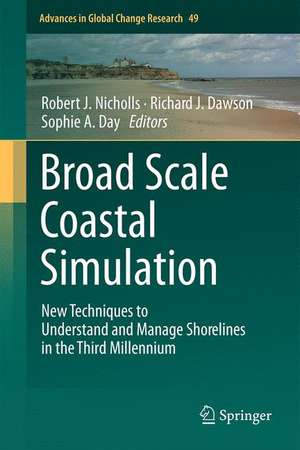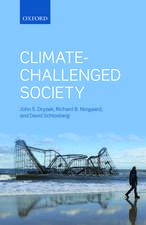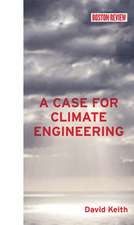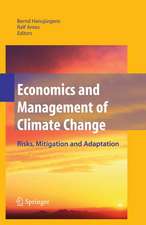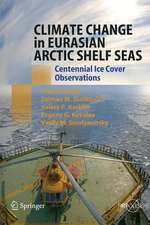Broad Scale Coastal Simulation: New Techniques to Understand and Manage Shorelines in the Third Millennium: Advances in Global Change Research, cartea 49
Editat de Robert J. Nicholls, Richard J. Dawson, Sophie A. Day (née Nicholson-Cole)en Limba Engleză Hardback – 11 sep 2015
| Toate formatele și edițiile | Preț | Express |
|---|---|---|
| Paperback (1) | 569.55 lei 38-44 zile | |
| SPRINGER NETHERLANDS – 21 feb 2018 | 569.55 lei 38-44 zile | |
| Hardback (1) | 593.48 lei 38-44 zile | |
| SPRINGER NETHERLANDS – 11 sep 2015 | 593.48 lei 38-44 zile |
Din seria Advances in Global Change Research
- 15%
 Preț: 636.12 lei
Preț: 636.12 lei -
 Preț: 439.83 lei
Preț: 439.83 lei - 18%
 Preț: 895.45 lei
Preț: 895.45 lei - 15%
 Preț: 648.24 lei
Preț: 648.24 lei - 18%
 Preț: 1036.54 lei
Preț: 1036.54 lei - 18%
 Preț: 894.16 lei
Preț: 894.16 lei - 18%
 Preț: 963.60 lei
Preț: 963.60 lei - 18%
 Preț: 1239.49 lei
Preț: 1239.49 lei - 15%
 Preț: 649.71 lei
Preț: 649.71 lei - 18%
 Preț: 1243.78 lei
Preț: 1243.78 lei - 18%
 Preț: 1114.02 lei
Preț: 1114.02 lei - 15%
 Preț: 648.89 lei
Preț: 648.89 lei - 18%
 Preț: 960.78 lei
Preț: 960.78 lei - 15%
 Preț: 643.99 lei
Preț: 643.99 lei - 18%
 Preț: 1834.44 lei
Preț: 1834.44 lei - 15%
 Preț: 649.06 lei
Preț: 649.06 lei - 18%
 Preț: 955.70 lei
Preț: 955.70 lei - 18%
 Preț: 956.03 lei
Preț: 956.03 lei - 18%
 Preț: 1232.26 lei
Preț: 1232.26 lei - 18%
 Preț: 955.88 lei
Preț: 955.88 lei - 18%
 Preț: 959.19 lei
Preț: 959.19 lei - 18%
 Preț: 944.82 lei
Preț: 944.82 lei - 18%
 Preț: 1105.19 lei
Preț: 1105.19 lei - 15%
 Preț: 644.49 lei
Preț: 644.49 lei - 15%
 Preț: 643.99 lei
Preț: 643.99 lei - 18%
 Preț: 1841.54 lei
Preț: 1841.54 lei - 18%
 Preț: 1225.94 lei
Preț: 1225.94 lei - 18%
 Preț: 954.62 lei
Preț: 954.62 lei - 5%
 Preț: 1414.80 lei
Preț: 1414.80 lei
Preț: 593.48 lei
Preț vechi: 741.86 lei
-20% Nou
Puncte Express: 890
Preț estimativ în valută:
113.58€ • 118.14$ • 93.76£
113.58€ • 118.14$ • 93.76£
Carte tipărită la comandă
Livrare economică 11-17 aprilie
Preluare comenzi: 021 569.72.76
Specificații
ISBN-13: 9789400752573
ISBN-10: 9400752571
Pagini: 380
Ilustrații: XXI, 398 p. 153 illus., 94 illus. in color. With online files/update.
Dimensiuni: 155 x 235 x 25 mm
Greutate: 0.95 kg
Ediția:1st ed. 2015
Editura: SPRINGER NETHERLANDS
Colecția Springer
Seria Advances in Global Change Research
Locul publicării:Dordrecht, Netherlands
ISBN-10: 9400752571
Pagini: 380
Ilustrații: XXI, 398 p. 153 illus., 94 illus. in color. With online files/update.
Dimensiuni: 155 x 235 x 25 mm
Greutate: 0.95 kg
Ediția:1st ed. 2015
Editura: SPRINGER NETHERLANDS
Colecția Springer
Seria Advances in Global Change Research
Locul publicării:Dordrecht, Netherlands
Public țintă
ResearchCuprins
Contents.- 1. The Challenge for Coastal Management During the Third Millennium.- 2. Climate Downscaling: Local Mean Sea-Level, Surge and Wave Modelling.- 3. Broad-Scale Hydrodynamic Simulation, Wave Transformation and Sediment Pathways.- 4. Land Use Dynamics and Coastal Management.- 5. Evaluating Broad-Scale Morphological Change in the Coastal Zone Using a Logic Based Behavioural Systems Approach.- 6. Coastal Wetland Habitats: Future Challenges and Potential Solutions.- 7. Simulating the Shore and Cliffs of North Norfolk.- 8. Broad Scale Coastal Inundation Modeling.- 9. Broad Scale Flood and Erosion Risk Analysis.- 10. Visualising Potential Coastal Change: Communicating Results Using Visualisation Techniques.- 11. The Coastal Simulator Interface: Integration and Application.- 12. Many Stakeholders, Multiple Perspectives: Long-Term Planning for a Future Coast.- 13. Living With Uncertainty: Difficult Choices for Coastal Management in the UK During the Third Millennium.- 14. Generic Lessons for Coastal Management in the Third Millennium.- Index.
Notă biografică
Robert Nicholls has studied coastal processes and coastal hazards for the last 25 years. In particular, he has an international reputation concerning climate change in coastal areas, especially the potential impacts and the possible responses. His research has involved studies across a range of scales from local (e.g., small towns) to the global. A distinctive dimension has been consideration of the coastal zone as a series of interacting systems which facilitates policy analysis. He has advised national governments (e.g., UK, Netherlands, Singapore, the Maldives) and intergovernmental organisations (e.g., OECD) on climate change and coastal issues, including as a lead author to five reports of the Intergovernmental Panel for Climate Change assessment process. Currently, he is contributing to a series of research projects, including being Principal Investigator as follows:
ESPA Deltas – an ESPA (DFID/NERC/ESRC-funded) project which is examining the future of ecosystem services and human well-being in coastal Bangladesh;
DECCMA – a CARRIA (IDRC/DFID-funded) project which is examining adaptation to climate change in the three contrasting deltas of the Volta, Mahanadi and Ganges-Brahmaputra Deltas, with a main focus on migration.
He was awarded the Roger Revelle Medal by the Intergovernmental Oceanographic Commission in 2008. This recognises ‘outstanding contributions to the ocean sciences by inspired researchers who communicate their knowledge and global vision of the challenges facing our Planet in order to shape a better future for humankind’.
See Web page: http://www.southampton.ac.uk/engineering/about/staff/rjn.page
- iCOASST – a NERC-funded consortium project on predicting
See Web page: http://www.southampton.ac.uk/engineering/about/staff/rjn.page
Textul de pe ultima copertă
This volume details research underpinning the ‘Coastal Simulator’ developed by the Tyndall Centre for Climate Change Research. The Simulator provides a framework to analyze long term coastal evolution taking account of all the relevant factors. These include the uncertain future climate and other conditions, such as land use change and allows evaluation of diverse management responses.
Coastal zones exemplify the environmental pressures we face: their beauty attracts settlement, they offer potential for diverse economic activities, and they are sensitive natural habitats for important species, as well as providing a range of ecosystem services. They are also extremely vulnerable to the vicissitudes of climate change, which include rising sea levels and changes in extreme events such as storms. With large populations living in coastal and estuarine cities facing the ongoing threat of inundation, coordinated management is essential, especially as coastal zones form a linked system in which piecemeal, uncoordinated management could be counterproductive.
The Simulator’s current detailed application to the Norfolk coast goes from global climate modelling and broad socio-economic change to the details of evolving coastal habitats, coastal erosion and coastal flood risk and their societal implications. This framework reflects the work of a multi-disciplinary team of key players who analysed these diverse factors in a coherent and integrated manner. The book offers a compelling synthesis of the lessons learned so far at national and international levels, drawing on the expertise of policy makers as well as respected figures in the field.
Coastal zones exemplify the environmental pressures we face: their beauty attracts settlement, they offer potential for diverse economic activities, and they are sensitive natural habitats for important species, as well as providing a range of ecosystem services. They are also extremely vulnerable to the vicissitudes of climate change, which include rising sea levels and changes in extreme events such as storms. With large populations living in coastal and estuarine cities facing the ongoing threat of inundation, coordinated management is essential, especially as coastal zones form a linked system in which piecemeal, uncoordinated management could be counterproductive.
The Simulator’s current detailed application to the Norfolk coast goes from global climate modelling and broad socio-economic change to the details of evolving coastal habitats, coastal erosion and coastal flood risk and their societal implications. This framework reflects the work of a multi-disciplinary team of key players who analysed these diverse factors in a coherent and integrated manner. The book offers a compelling synthesis of the lessons learned so far at national and international levels, drawing on the expertise of policy makers as well as respected figures in the field.
Caracteristici
A stepwise guide to the integrated assessment of coastal areas Breadth of perspective applicable to global strategic coastal management Includes the first quantitative assessment of the relationship between the risks of erosion and flooding Real case studies deployed as examples of applied methods Synthesizes lessons at both national and international levels
